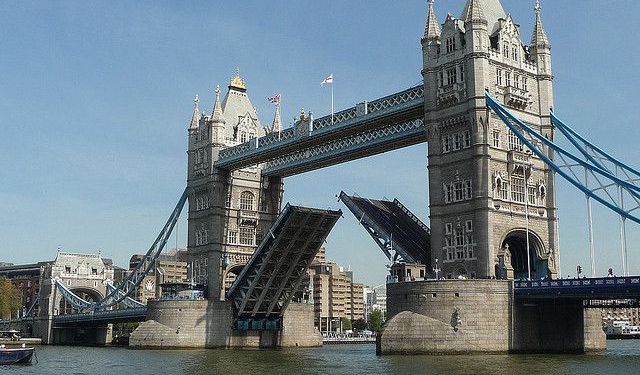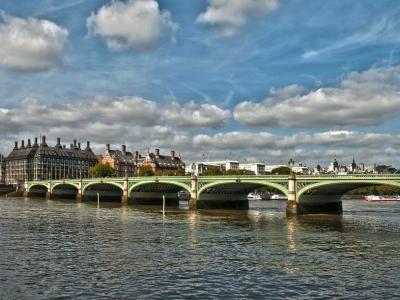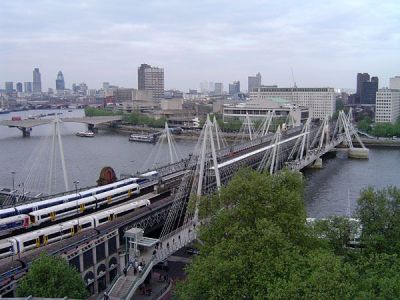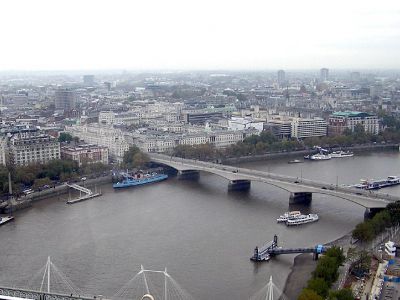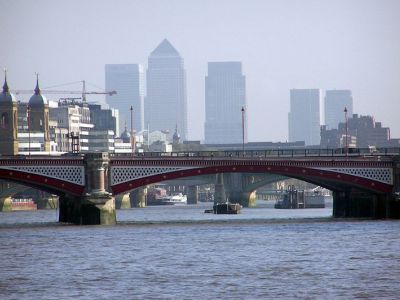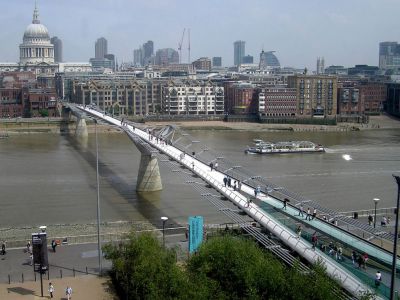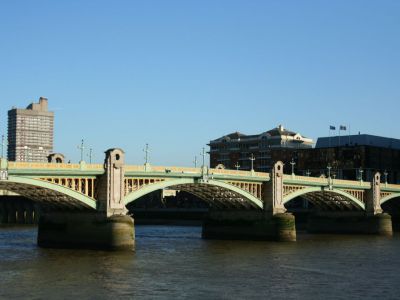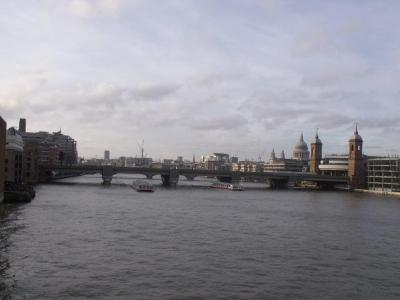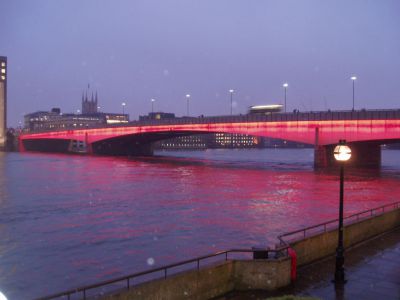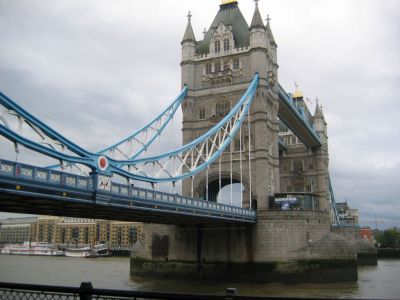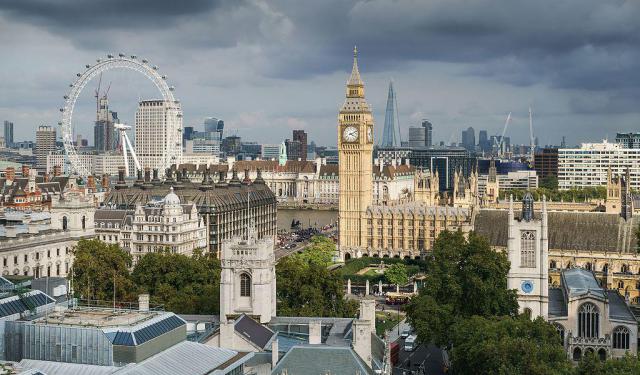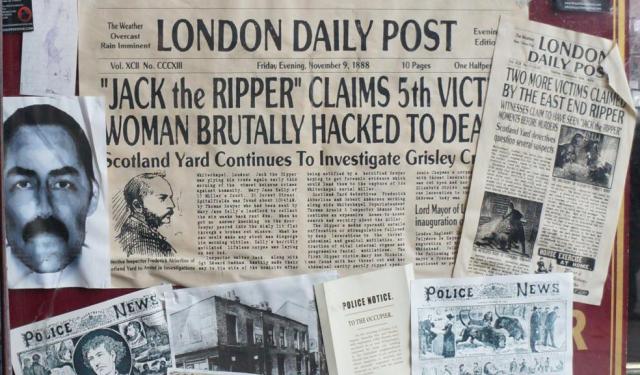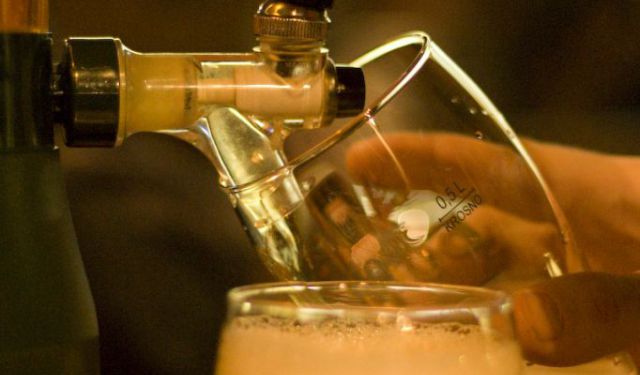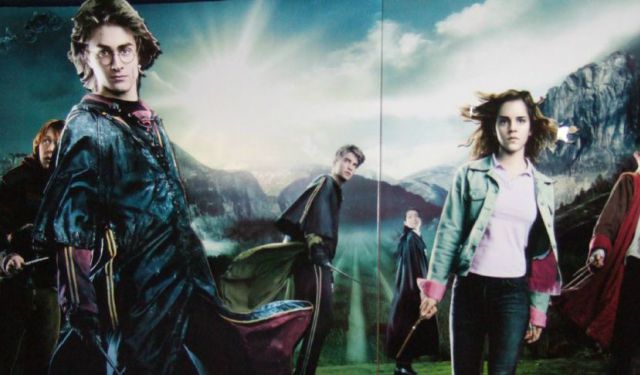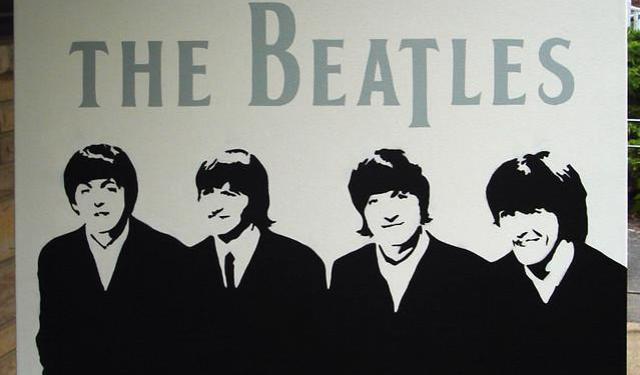Bridges of London (Self Guided), London
Around thirty bridges span the Thames river in London, each with its own story. Our self-guided walk takes you to see nine such historical structures located in the heart of the city, starting from the storied Westminster Bridge and ending at the iconic Tower Bridge.
The latter has stood over the River Thames in London since 1894 and is one of the finest, most recognizable bridges in the world. It is the London bridge you tend to see in movies (e.g. "Mission: Impossible", "Trainspotting", "The Elephant Man", "Killing Eve") and on advertising literature for London.
Meanwhile, Millennium Bridge has been quite popular with Harry Potter fans since being featured in "Harry Potter and the Half-Blood Prince".
Earlier on, in the 1930s, Robert E Sherwood's play ‘Waterloo Bridge’ was such a popular story, it was made into three separate films, released in 1931, 1940 and 1956; the second of these film versions starred Vivien Leigh and Robert Taylor, and was Oscar-nominated. The film tells the story of a soldier who falls in love and marries a woman he meets on Waterloo Bridge during a First World War air raid.
On this leisurely stroll along the north bank of the Thames, you will find many other historical landmarks of the British capital whilst taking in excellent views of Westminster Parliament, the London Eye Wheel, the South Bank and more.
Before setting out, just make sure to have your camera ready because the views will be incredible!
The latter has stood over the River Thames in London since 1894 and is one of the finest, most recognizable bridges in the world. It is the London bridge you tend to see in movies (e.g. "Mission: Impossible", "Trainspotting", "The Elephant Man", "Killing Eve") and on advertising literature for London.
Meanwhile, Millennium Bridge has been quite popular with Harry Potter fans since being featured in "Harry Potter and the Half-Blood Prince".
Earlier on, in the 1930s, Robert E Sherwood's play ‘Waterloo Bridge’ was such a popular story, it was made into three separate films, released in 1931, 1940 and 1956; the second of these film versions starred Vivien Leigh and Robert Taylor, and was Oscar-nominated. The film tells the story of a soldier who falls in love and marries a woman he meets on Waterloo Bridge during a First World War air raid.
On this leisurely stroll along the north bank of the Thames, you will find many other historical landmarks of the British capital whilst taking in excellent views of Westminster Parliament, the London Eye Wheel, the South Bank and more.
Before setting out, just make sure to have your camera ready because the views will be incredible!
How it works: Download the app "GPSmyCity: Walks in 1K+ Cities" from Apple App Store or Google Play Store to your mobile phone or tablet. The app turns your mobile device into a personal tour guide and its built-in GPS navigation functions guide you from one tour stop to next. The app works offline, so no data plan is needed when traveling abroad.
Bridges of London Map
Guide Name: Bridges of London
Guide Location: England » London (See other walking tours in London)
Guide Type: Self-guided Walking Tour (Sightseeing)
# of Attractions: 9
Tour Duration: 2 Hour(s)
Travel Distance: 5.2 Km or 3.2 Miles
Author: DanaOffice
Sight(s) Featured in This Guide:
Guide Location: England » London (See other walking tours in London)
Guide Type: Self-guided Walking Tour (Sightseeing)
# of Attractions: 9
Tour Duration: 2 Hour(s)
Travel Distance: 5.2 Km or 3.2 Miles
Author: DanaOffice
Sight(s) Featured in This Guide:
- Westminster Bridge
- Hungerford Bridge
- Waterloo Bridge
- Blackfriars Bridge
- Millennium Bridge
- Southwark Bridge
- Cannon Street Railway Bridge
- London Bridge
- Tower Bridge
1) Westminster Bridge
Westminster Bridge is the bridge that nobody initially wanted. Back in the day, the Church, the City, and especially the watermen (who were not too keen on losing their river taxi business) all threw shade at the idea. But once it was finally built-with 15 graceful semi-circular arches-it was hailed as the first proper stone bridge across the Thames in over 500 years. Suddenly, everybody loved it-especially artists like Samuel Scott, Canaletto, and Claude Monet, who all went watercolor-wild, capturing its curves.
But then came the drama. In 1831, the old, crumbling London Bridge was torn down, which-surprise!-changed the river’s flow and started eroding Westminster Bridge’s foundations like a soggy biscuit. Something had to be done, so Parliament passed an Act in 1853, handing over the bridge to the Commissioners of Public Works. It was at that point that Thomas Page, the engineer, came along with Sir Charles Barry, fresh off designing the new Houses of Parliament (after the great fire of 1834), who was brought in to make sure that the new bridge would match Parliament’s fancy new Gothic threads.
The result was a beauty unveiled on Queen Victoria’s 43rd birthday, May 24, 1862-complete with a 25-gun salute for her 25 years of ruling the realm. The bridge stretches 827 feet across the Thames and flaunts seven elliptical cast-iron arches, gray granite abutments, and more neo-Gothic flair than a Victorian novel. As for the green paint, that’s a cheeky nod to the House of Commons (which, conveniently, is the closest part of Parliament to the bridge). And if you look closely, the ornate ironwork is dripping with UK symbolism: portcullises, roses, thistles, shields, and St. George’s cross.
The view from the middle of the bridge is a postcard waiting to happen. You’ve got the Palace of Westminster on the one side, the London Eye on the other, and the Thames doing its timeless shimmer underneath. North, south, east-there’s not a bad angle in sight. So go on-strike a pose, soak in the skyline, and cross like a monarch.
But then came the drama. In 1831, the old, crumbling London Bridge was torn down, which-surprise!-changed the river’s flow and started eroding Westminster Bridge’s foundations like a soggy biscuit. Something had to be done, so Parliament passed an Act in 1853, handing over the bridge to the Commissioners of Public Works. It was at that point that Thomas Page, the engineer, came along with Sir Charles Barry, fresh off designing the new Houses of Parliament (after the great fire of 1834), who was brought in to make sure that the new bridge would match Parliament’s fancy new Gothic threads.
The result was a beauty unveiled on Queen Victoria’s 43rd birthday, May 24, 1862-complete with a 25-gun salute for her 25 years of ruling the realm. The bridge stretches 827 feet across the Thames and flaunts seven elliptical cast-iron arches, gray granite abutments, and more neo-Gothic flair than a Victorian novel. As for the green paint, that’s a cheeky nod to the House of Commons (which, conveniently, is the closest part of Parliament to the bridge). And if you look closely, the ornate ironwork is dripping with UK symbolism: portcullises, roses, thistles, shields, and St. George’s cross.
The view from the middle of the bridge is a postcard waiting to happen. You’ve got the Palace of Westminster on the one side, the London Eye on the other, and the Thames doing its timeless shimmer underneath. North, south, east-there’s not a bad angle in sight. So go on-strike a pose, soak in the skyline, and cross like a monarch.
2) Hungerford Bridge
Hungerford Bridge is a railway bridge that spans the Thames River, situated between the Waterloo and Westminster bridges. The bridge comprises two distinct sections. The older central part, known as "Charing Cross Bridge", consists of steel beams housing railway tracks. Flanking this central portion are newer footbridges, each measuring 4 meters in width, referred to as the Golden Jubilee Bridges, which were added in 2002. Access to these footbridges is available via staircases and elevators.
The original bridge was constructed in 1845, initially intended solely for pedestrian use. Fourteen years later, it underwent reconstruction to accommodate railway needs. Subsequently, in the 1990s, the pedestrian walkways, then named Hungerford Footbridges, underwent modernization. In 2003, the Golden Jubilee Bridges received the Royal Fine Art Commission Award, followed by the Institution of Structural Engineers Award in the following year.
Hungerford Bridge offers spectacular vistas, particularly when heading towards the South Bank. Along the way, you'll encounter artists and entertainers, and you'll have the opportunity to enjoy sweeping views of the Thames adorned with prominent landmarks, including the London Eye. On a sunny day, it's a delight to stand here, but its allure remains equally captivating after dark. Walking beneath the suspension cables at night provides an unparalleled experience, making it an ideal spot for capturing panoramic photos of the Thames.
The original bridge was constructed in 1845, initially intended solely for pedestrian use. Fourteen years later, it underwent reconstruction to accommodate railway needs. Subsequently, in the 1990s, the pedestrian walkways, then named Hungerford Footbridges, underwent modernization. In 2003, the Golden Jubilee Bridges received the Royal Fine Art Commission Award, followed by the Institution of Structural Engineers Award in the following year.
Hungerford Bridge offers spectacular vistas, particularly when heading towards the South Bank. Along the way, you'll encounter artists and entertainers, and you'll have the opportunity to enjoy sweeping views of the Thames adorned with prominent landmarks, including the London Eye. On a sunny day, it's a delight to stand here, but its allure remains equally captivating after dark. Walking beneath the suspension cables at night provides an unparalleled experience, making it an ideal spot for capturing panoramic photos of the Thames.
3) Waterloo Bridge
Waterloo Bridge, named in commemoration of the British triumph at the Battle of Waterloo in 1815, marks the eastern boundary of the Southbank Centre and is renowned for more than just its stunning sunsets. During the Second World War, it was predominantly constructed by women, and in 1978, it gained notoriety as the site of the assassination of Bulgarian dissident Georgi Markov, who fell victim to a ricin-loaded umbrella. On clear evenings, it's a common sight to encounter a lineup of both professional and amateur photographers along its length. This vantage point offers a 360-degree vista of the London skyline, providing fantastic photographic opportunities in both daylight and nighttime settings.
For a particularly romantic perspective of London, stand at the midpoint between the north and south banks of the Thames on the bridge. Facing east, you'll behold the magnificent Saint Paul's Cathedral and the graceful neoclassical facades of Somerset House, along with contemporary landmarks such as the distinctive "Gherkin" skyscraper on the north side and the towering Shard pyramid to the south. Gazing westward, you'll spot the iconic Victorian Gothic towers of the Palace of Westminster (Houses of Parliament) and Big Ben on the north bank, as well as the Edwardian elegance of The Savoy hotel and the National Liberal Club. You'll also catch a glimpse of Westminster Abbey. Turning your attention to the south bank, your eyes will be drawn to the London Eye's wheel and the striking Southbank Centre with its Brutalist architecture. If timed right, you may witness the sunset that inspired the Kinks' famous song.
Tip:
Should you find yourself in London during a full moonlit night, take the opportunity to spend an hour on this bridge after sunset and indulge in the awe-inspiring vistas!
For a particularly romantic perspective of London, stand at the midpoint between the north and south banks of the Thames on the bridge. Facing east, you'll behold the magnificent Saint Paul's Cathedral and the graceful neoclassical facades of Somerset House, along with contemporary landmarks such as the distinctive "Gherkin" skyscraper on the north side and the towering Shard pyramid to the south. Gazing westward, you'll spot the iconic Victorian Gothic towers of the Palace of Westminster (Houses of Parliament) and Big Ben on the north bank, as well as the Edwardian elegance of The Savoy hotel and the National Liberal Club. You'll also catch a glimpse of Westminster Abbey. Turning your attention to the south bank, your eyes will be drawn to the London Eye's wheel and the striking Southbank Centre with its Brutalist architecture. If timed right, you may witness the sunset that inspired the Kinks' famous song.
Tip:
Should you find yourself in London during a full moonlit night, take the opportunity to spend an hour on this bridge after sunset and indulge in the awe-inspiring vistas!
4) Blackfriars Bridge
Blackfriars Bridge is tangible proof that even bridges in London have dramatic backstories and excellent taste in accessories.
The original structure made its debut in 1769, the brainchild of 26-year-old architectural prodigy Robert Mylne. He had just returned from Rome, full of Renaissance dreams and Piranesi prints, and decided to channel them into nine graceful, semi-elliptical arches of Portland stone. A scenic marvel with St. Paul’s Cathedral looming nobly in the background, it was so picturesque that 18th-century painters couldn’t resist putting it on canvas. One of the best-known results is William Marlow’s romantic rendering of Saint Paul’s from the South Bank. Very moody. Very oil-paint-on-canvas energy.
But alas, arches don’t last forever, especially when river water gets feisty. By 1869, Queen Victoria cut the ribbon on the new-and-improved Blackfriars Road Bridge, almost exactly a century after its predecessor was inaugurated. This time, engineers ditched the stone and went full steam ahead with five elliptical wrought-iron arches, designed not to upset the Thames or its boat traffic. The bridge’s granite piers, styled like medieval pulpits, are a nod to the 13th-century Dominican friary that gave the area its name. (No, not a brand of gin, though that would've been fun.) As for the color scheme, it's red, white, gold, and plenty of royal drama.
Look closely and you’ll spot seabirds on the east side, freshwater birds on the west, and a very stoic silver dragon guarding the entrance to the City of London like a mythical customs officer.
By 1910, the bridge had to bulk up-hello, trams and London’s ever-growing swarm of vehicles. Today, it spans a beefy 105 feet (or 32 meters), making it the widest bridge over the Thames. That’s right: a true heavyweight champion of river crossings.
More recently (in 2007), Blackfriars Bridge had its own moment of magic for Potterheads, soaring onto the silver screen in Harry Potter and the Order of the Phoenix, when the Order whisked Harry away from Privet Drive to Grimmauld Place. Look closely, and you’ll catch them flying under the Blackfriars, capes flapping and all that. Muggles didn’t even blink.
Tip:
Wander into the southern pedestrian subway and you’ll still see Mylne’s original bridge, lovingly preserved in tile. Because even demolished bridges deserve a good portrait.
The original structure made its debut in 1769, the brainchild of 26-year-old architectural prodigy Robert Mylne. He had just returned from Rome, full of Renaissance dreams and Piranesi prints, and decided to channel them into nine graceful, semi-elliptical arches of Portland stone. A scenic marvel with St. Paul’s Cathedral looming nobly in the background, it was so picturesque that 18th-century painters couldn’t resist putting it on canvas. One of the best-known results is William Marlow’s romantic rendering of Saint Paul’s from the South Bank. Very moody. Very oil-paint-on-canvas energy.
But alas, arches don’t last forever, especially when river water gets feisty. By 1869, Queen Victoria cut the ribbon on the new-and-improved Blackfriars Road Bridge, almost exactly a century after its predecessor was inaugurated. This time, engineers ditched the stone and went full steam ahead with five elliptical wrought-iron arches, designed not to upset the Thames or its boat traffic. The bridge’s granite piers, styled like medieval pulpits, are a nod to the 13th-century Dominican friary that gave the area its name. (No, not a brand of gin, though that would've been fun.) As for the color scheme, it's red, white, gold, and plenty of royal drama.
Look closely and you’ll spot seabirds on the east side, freshwater birds on the west, and a very stoic silver dragon guarding the entrance to the City of London like a mythical customs officer.
By 1910, the bridge had to bulk up-hello, trams and London’s ever-growing swarm of vehicles. Today, it spans a beefy 105 feet (or 32 meters), making it the widest bridge over the Thames. That’s right: a true heavyweight champion of river crossings.
More recently (in 2007), Blackfriars Bridge had its own moment of magic for Potterheads, soaring onto the silver screen in Harry Potter and the Order of the Phoenix, when the Order whisked Harry away from Privet Drive to Grimmauld Place. Look closely, and you’ll catch them flying under the Blackfriars, capes flapping and all that. Muggles didn’t even blink.
Tip:
Wander into the southern pedestrian subway and you’ll still see Mylne’s original bridge, lovingly preserved in tile. Because even demolished bridges deserve a good portrait.
5) Millennium Bridge
The Millennium Bridge-London’s bold leap into the 21st century, and quite literally, a wobbly one.
This sleek steel span holds not one, not two, but three distinctions. First, it’s the youngest of the Thames crossings. Second, it’s the only bridge in London where cars are banished-only pedestrians, photographers, and the occasional rollerblader. And third? It set a record for the fastest closure in UK bridge history. Opened with great fanfare... then swiftly shut down just two days later because, well, it couldn’t handle people's excitement. Or their footsteps...
Designed to mark the year 2000, the bridge was formally inaugurated by Queen Elizabeth II as the winning brainchild of Foster & Partners and Ove Arup & Partners-those clever folks you call when you want something to be both futuristic and structurally sound. Stretching 325 meters (or 1060+ feet), it tiptoes across the Thames with eight low-slung suspension cables (tensioned to exert a formidable 2000-ton force against the sturdy piers rooted on each bank) that don’t dare obstruct your Insta-worthy shot of St. Paul’s Cathedral.
Indeed, as a pedestrian-only portal between the Tate Modern and Shakespeare’s Globe on one end, and the mighty dome of St. Paul’s on the other, the views it affords are truly a chef’s kiss.
Of course, its opening-day wobble-thanks to 90,000 enthusiastic pedestrians striding in unintentional unison-earned it the affectionate moniker “The Wobbly Bridge.” But fear not: engineers came to the rescue with over 50 high-tech dampers and stabilizers galore, and by 2002, the bridge was back in action, shimmy-free.
Speaking of dramatic comebacks-yes, that was the very bridge you saw disintegrating in Harry Potter and the Half-Blood Prince. Death Eaters swoop in, chaos erupts, and the Millennium Bridge bends like a paperclip. Don’t worry, though-it was all movie magic. The real bridge stood firm and survived the scene unscathed, unlike its fictional counterpart.
Tip:
Wear good walking shoes, bring a raincoat (because it's London), and don’t forget to glance down-sometimes there are funky little art stickers underfoot. Because, again, this is London, and even the pavement might be making a statement.
This sleek steel span holds not one, not two, but three distinctions. First, it’s the youngest of the Thames crossings. Second, it’s the only bridge in London where cars are banished-only pedestrians, photographers, and the occasional rollerblader. And third? It set a record for the fastest closure in UK bridge history. Opened with great fanfare... then swiftly shut down just two days later because, well, it couldn’t handle people's excitement. Or their footsteps...
Designed to mark the year 2000, the bridge was formally inaugurated by Queen Elizabeth II as the winning brainchild of Foster & Partners and Ove Arup & Partners-those clever folks you call when you want something to be both futuristic and structurally sound. Stretching 325 meters (or 1060+ feet), it tiptoes across the Thames with eight low-slung suspension cables (tensioned to exert a formidable 2000-ton force against the sturdy piers rooted on each bank) that don’t dare obstruct your Insta-worthy shot of St. Paul’s Cathedral.
Indeed, as a pedestrian-only portal between the Tate Modern and Shakespeare’s Globe on one end, and the mighty dome of St. Paul’s on the other, the views it affords are truly a chef’s kiss.
Of course, its opening-day wobble-thanks to 90,000 enthusiastic pedestrians striding in unintentional unison-earned it the affectionate moniker “The Wobbly Bridge.” But fear not: engineers came to the rescue with over 50 high-tech dampers and stabilizers galore, and by 2002, the bridge was back in action, shimmy-free.
Speaking of dramatic comebacks-yes, that was the very bridge you saw disintegrating in Harry Potter and the Half-Blood Prince. Death Eaters swoop in, chaos erupts, and the Millennium Bridge bends like a paperclip. Don’t worry, though-it was all movie magic. The real bridge stood firm and survived the scene unscathed, unlike its fictional counterpart.
Tip:
Wear good walking shoes, bring a raincoat (because it's London), and don’t forget to glance down-sometimes there are funky little art stickers underfoot. Because, again, this is London, and even the pavement might be making a statement.
6) Southwark Bridge
The original Southwark Bridge, previously known as Queen Street Bridge and designed by John Rennie, reached completion in 1819. To promote a remarkable innovation, its official opening occurred at midnight, featuring the illumination of 30 gas lamps. This bridge, during its time, stood as the largest cast iron structure; however, it suffered from low utilization and lacked the capacity to support heavy goods vehicles, ultimately leading to its demolition.
In 1921, a new bridge designed by architect Sir Ernest George and engineer Basil Mott was inaugurated, albeit after substantial construction delays caused by the First World War. Distinct from London and Blackfriars Bridges, Southwark Bridge does not bear silver dragons to demarcate the city boundary on the southern bank of the Thames, as its financing was privately arranged.
The bridge comprises cast iron arches complemented by grey granite abutments and balustrades. It is painted in green and yellow hues and features sentry-box-like structures atop the turreted pier headings. Beneath it, on the southern landing, remnants of old steps remain, once serving as a landing dock for Thames watermen to moor their boats and await customers. In an era when there were fewer bridges spanning the Thames, these watermen provided the primary means of river transportation.
On the north bank of Southwark Bridge, there is a pedestrian tunnel adorned with a wall mural depicting scenes of Thames frost fairs. During various winters between the 17th and early 19th centuries, a period known as 'the Little Ice Age', the Thames froze over, allowing Londoners to host festivals with food stalls, shops, sporting events, and even temporary pubs on the frozen river's surface. The tightly spaced piers of London Bridge disrupted the river's flow, contributing to the freezing phenomenon during these extraordinary events.
In 1921, a new bridge designed by architect Sir Ernest George and engineer Basil Mott was inaugurated, albeit after substantial construction delays caused by the First World War. Distinct from London and Blackfriars Bridges, Southwark Bridge does not bear silver dragons to demarcate the city boundary on the southern bank of the Thames, as its financing was privately arranged.
The bridge comprises cast iron arches complemented by grey granite abutments and balustrades. It is painted in green and yellow hues and features sentry-box-like structures atop the turreted pier headings. Beneath it, on the southern landing, remnants of old steps remain, once serving as a landing dock for Thames watermen to moor their boats and await customers. In an era when there were fewer bridges spanning the Thames, these watermen provided the primary means of river transportation.
On the north bank of Southwark Bridge, there is a pedestrian tunnel adorned with a wall mural depicting scenes of Thames frost fairs. During various winters between the 17th and early 19th centuries, a period known as 'the Little Ice Age', the Thames froze over, allowing Londoners to host festivals with food stalls, shops, sporting events, and even temporary pubs on the frozen river's surface. The tightly spaced piers of London Bridge disrupted the river's flow, contributing to the freezing phenomenon during these extraordinary events.
7) Cannon Street Railway Bridge
Cannon Street's name has no connection to artillery; instead, it originates from the Middle English term 'candelwrichstrete', signifying the 'street of candle makers', dating back to the 12th century. The bridge itself, initially opened in 1866, boasts five impressive spans supported by cast iron Doric columns. It was officially designated the Alexandra Bridge in tribute to Princess Alexandra of Denmark, who wed Edward, Prince of Wales, in 1863.
The original construction featured two footpaths, one serving as a public toll-path and the other reserved exclusively for railway employees. In 1893, during a widening and strengthening project, these footpaths were removed, and four additional cast-iron cylinders were added to the upstream side of each pier.
Over the past century, the bridge has undergone two complete reconstructions. The Second World War inflicted significant damage on the station, leading to the removal of many original ornamental elements during extensive renovations carried out by British Rail in 1982. Nonetheless, two brick towers from the original bridge still stand along the riverfront. These towers flank the northern side of the bridge and conceal sizable reservoirs containing water, which powers the hydraulic lifts at Cannon Street station.
The original construction featured two footpaths, one serving as a public toll-path and the other reserved exclusively for railway employees. In 1893, during a widening and strengthening project, these footpaths were removed, and four additional cast-iron cylinders were added to the upstream side of each pier.
Over the past century, the bridge has undergone two complete reconstructions. The Second World War inflicted significant damage on the station, leading to the removal of many original ornamental elements during extensive renovations carried out by British Rail in 1982. Nonetheless, two brick towers from the original bridge still stand along the riverfront. These towers flank the northern side of the bridge and conceal sizable reservoirs containing water, which powers the hydraulic lifts at Cannon Street station.
8) London Bridge
For pretty much as long as London has been… well, London, there’s been a bridge standing right here. The first one went up over 2,000 years ago, and since then it’s been a bit of a revolving door for bridges-Romans built one, William the Conqueror gave it a go, and King John had his moment too.
Back in 1014, when the Danes were running the show in London, King Ethelred the Unready-a man as prepared for battle as his name suggests-decided to team up with King Olaf of Norway and a band of Vikings. Yes, Saxons and Vikings were together at last. They sailed up the Thames, tied ropes to the wooden supports of the bridge, let the tide carry them downstream, and yoink!-down came the bridge. And just like that, the world got its catchiest medieval jingle: “London Bridge is Falling Down.”
By Tudor times, the bridge was basically a medieval high street, with 600 buildings, some six stories tall, crammed shoulder to shoulder. It was so packed, it became its own city ward. And as if bumper-to-bumper Tudor traffic wasn’t enough, the bridge also had a rather grim flair for home decor-namely, the severed heads of traitors displayed proudly on spikes. Yikes...
But the bridge couldn’t handle the modern hustle. By the 1960s, it was literally sinking at one end, buckling under the weight of traffic and time. So what did Britain do? Sell it, of course! For £1 million, or about $2.4 million back then, an American oil tycoon bought it, shipped it piece-by-piece across the Atlantic, and reassembled it over a lake in Arizona, where it stands to this day, probably wondering what happened.
The current London Bridge, built in 1973, is a minimalist affair: clean lines, pre-stressed concrete, some polished granite, and about as much flair as a spreadsheet. But hey-it gets the job done.
And once a year, for one glorious Sunday in autumn, the bridge trades buses and bikes for a flock of sheep. It's the Sheep Drive, an ancient right of the Freemen of the City, who lead their woolly companions across the bridge in a ceremony that's part tradition, part traffic-stopping spectacle.
Because why not?
Back in 1014, when the Danes were running the show in London, King Ethelred the Unready-a man as prepared for battle as his name suggests-decided to team up with King Olaf of Norway and a band of Vikings. Yes, Saxons and Vikings were together at last. They sailed up the Thames, tied ropes to the wooden supports of the bridge, let the tide carry them downstream, and yoink!-down came the bridge. And just like that, the world got its catchiest medieval jingle: “London Bridge is Falling Down.”
By Tudor times, the bridge was basically a medieval high street, with 600 buildings, some six stories tall, crammed shoulder to shoulder. It was so packed, it became its own city ward. And as if bumper-to-bumper Tudor traffic wasn’t enough, the bridge also had a rather grim flair for home decor-namely, the severed heads of traitors displayed proudly on spikes. Yikes...
But the bridge couldn’t handle the modern hustle. By the 1960s, it was literally sinking at one end, buckling under the weight of traffic and time. So what did Britain do? Sell it, of course! For £1 million, or about $2.4 million back then, an American oil tycoon bought it, shipped it piece-by-piece across the Atlantic, and reassembled it over a lake in Arizona, where it stands to this day, probably wondering what happened.
The current London Bridge, built in 1973, is a minimalist affair: clean lines, pre-stressed concrete, some polished granite, and about as much flair as a spreadsheet. But hey-it gets the job done.
And once a year, for one glorious Sunday in autumn, the bridge trades buses and bikes for a flock of sheep. It's the Sheep Drive, an ancient right of the Freemen of the City, who lead their woolly companions across the bridge in a ceremony that's part tradition, part traffic-stopping spectacle.
Because why not?
9) Tower Bridge (must see)
Tower Bridge-yes, that famous one with the twin towers and rising roadways-surprisingly didn’t swing into action until 1894. That’s right: it’s younger than your great-great-grandma’s fruitcake recipe, though you'd never guess it based on the number of fridge magnets it’s starred on. Indeed, in just over a century, it’s managed to become one of London’s most iconic symbols-practically the Victorian era in bridge form.
Now here’s a royal twist: Queen Victoria wasn’t exactly thrilled about it at first. She worried the bridge might compromise the security of the nearby Tower of London, which at that time doubled as an armory. Still, they painted it her favorite color-chocolate brown-and forged ahead, perhaps hoping that a well-dressed bridge would soothe Her Majesty’s nerves.
Under the hood (well, under the road), it was all quite steamy-literally. Sophisticated steam-powered engines lifted the bridge’s bascules to allow tall ships to pass through. In its very first year, the bridge went up over 6,000 times-talk about an overachiever! These days, it opens around 1,000 times a year, and somehow, they’ve managed to avoid any major mishaps. If you’re lucky, you might even catch one of those dramatic lifts in real time-free theater, London-style...
For an unforgettable experience, take in the sweeping views of the Thames, the sci-fi egg that is City Hall, the gleaming glass Shard, and the chaos of central London from the top of the bridge. Better yet, grab a ticket and ride the elevator to the elevated walkways. Up there, you’ll find a glass floor for peeking at the world below (great for photos, or mild panic), plus a museum showcasing the original steam engines-because nothing says Victorian romance like big brass machinery. Bonus points: Yes, there are restrooms at the top, so no need to “hold it” at altitude.
And in case you wonder, why you should go?-This masterpiece of Victorian engineering also sparkles at night, and-let’s face it-your trip to London wouldn't be complete without seeing it.
Now here’s a royal twist: Queen Victoria wasn’t exactly thrilled about it at first. She worried the bridge might compromise the security of the nearby Tower of London, which at that time doubled as an armory. Still, they painted it her favorite color-chocolate brown-and forged ahead, perhaps hoping that a well-dressed bridge would soothe Her Majesty’s nerves.
Under the hood (well, under the road), it was all quite steamy-literally. Sophisticated steam-powered engines lifted the bridge’s bascules to allow tall ships to pass through. In its very first year, the bridge went up over 6,000 times-talk about an overachiever! These days, it opens around 1,000 times a year, and somehow, they’ve managed to avoid any major mishaps. If you’re lucky, you might even catch one of those dramatic lifts in real time-free theater, London-style...
For an unforgettable experience, take in the sweeping views of the Thames, the sci-fi egg that is City Hall, the gleaming glass Shard, and the chaos of central London from the top of the bridge. Better yet, grab a ticket and ride the elevator to the elevated walkways. Up there, you’ll find a glass floor for peeking at the world below (great for photos, or mild panic), plus a museum showcasing the original steam engines-because nothing says Victorian romance like big brass machinery. Bonus points: Yes, there are restrooms at the top, so no need to “hold it” at altitude.
And in case you wonder, why you should go?-This masterpiece of Victorian engineering also sparkles at night, and-let’s face it-your trip to London wouldn't be complete without seeing it.
Walking Tours in London, England
Create Your Own Walk in London
Creating your own self-guided walk in London is easy and fun. Choose the city attractions that you want to see and a walk route map will be created just for you. You can even set your hotel as the start point of the walk.
London Introduction Walking Tour
London: the capital of England, heart of the UK, and international heavyweight in history, culture, and sheer charm. Its name comes straight out of Rome. Londinium was founded circa 43 AD as a trading post. Then came Queen Boudica in 61 AD, who, let’s say, didn’t care much for Roman urban planning and burnt it to the ground. But Londinium wasn’t one to stay down-it bounced back, flourished,... view more
Tour Duration: 2 Hour(s)
Travel Distance: 4.2 Km or 2.6 Miles
Tour Duration: 2 Hour(s)
Travel Distance: 4.2 Km or 2.6 Miles
Jack the Ripper Walking Tour
Jack the Ripper, an unidentified serial killer who terrorized the British capital in 1888, became notorious for the series of brutal and gruesome murders that he carried out in the East End of London. The primary setting for the Jack the Ripper attacks was Whitechapel, at the time a poverty-stricken and crime-ridden district, known for its dark alleys and narrow streets.
The name "Jack the... view more
Tour Duration: 2 Hour(s)
Travel Distance: 4.0 Km or 2.5 Miles
The name "Jack the... view more
Tour Duration: 2 Hour(s)
Travel Distance: 4.0 Km or 2.5 Miles
London's Historic Pubs Walk
If there’s any more iconic symbol for London than Big Ben or the London Eye, then it must be the traditional English pub. And London sure is full of them, dating from pre-Victorian times to just about five minutes ago.
With so much history surrounding London there is no shortage of historic pubs to choose from. Whether you fancy half-timbered, rambling watering holes or small but perfectly... view more
Tour Duration: 3 Hour(s)
Travel Distance: 5.6 Km or 3.5 Miles
With so much history surrounding London there is no shortage of historic pubs to choose from. Whether you fancy half-timbered, rambling watering holes or small but perfectly... view more
Tour Duration: 3 Hour(s)
Travel Distance: 5.6 Km or 3.5 Miles
Shakespeare's London Walking Tour
You might know him as “the Bard,” but to England, William Shakespeare is practically the patron saint of poetic plot twists. Born in 1564 in Stratford-upon-Avon to John Shakespeare, a glove maker and town official, and Mary Arden from a prosperous farming family, young William started life with ink in his veins and Latin on his mind. Grammar school likely gave him his first taste of rhetoric.... view more
Tour Duration: 3 Hour(s)
Travel Distance: 4.7 Km or 2.9 Miles
Tour Duration: 3 Hour(s)
Travel Distance: 4.7 Km or 2.9 Miles
Harry Potter Walking Tour I
The Harry Potter phenomenon began with author J.K. Rowling, who famously dreamed up the series while delayed on a train from Manchester to London. With the release of Harry Potter and the Philosopher’s Stone in 1997, the literary world changed forever. Across seven books, readers followed Harry’s evolution from an orphaned schoolboy at Hogwarts to a brave young wizard confronting evil... view more
Tour Duration: 2 Hour(s)
Travel Distance: 2.7 Km or 1.7 Miles
Tour Duration: 2 Hour(s)
Travel Distance: 2.7 Km or 1.7 Miles
Beatles London Walking Tour
The Beatles, often hailed as one of the most influential bands in music history, began their journey in Liverpool in 1960, but it was in London that they truly became global icons. While Liverpool gave them their start, the British capital became their professional playground during the peak of Beatlemania. From recording sessions and business deals to public performances and personal milestones,... view more
Tour Duration: 3 Hour(s)
Travel Distance: 4.8 Km or 3 Miles
Tour Duration: 3 Hour(s)
Travel Distance: 4.8 Km or 3 Miles
Useful Travel Guides for Planning Your Trip
London Souvenirs: 18 Distinctively British Products for Travelers
Most visitors to London consider shopping as part of their must-do London experience. From street markets to Victorian arcades to snobbish Sloane Square to busy Oxford Street, there are a host of shops selling items which typically represent this vibrant city. Whether you are shopping for souvenirs...
The Most Popular Cities
/ view all
